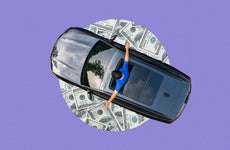Average car payments in 2024: What to expect

The Bankrate promise
At Bankrate we strive to help you make smarter financial decisions. While we adhere to strict , this post may contain references to products from our partners. Here's an explanation for .
Drivers’ average car payments top $730 and $520 for new and used vehicles, respectively, according to Experian. For many Americans, their vehicle payment is the second biggest hit to their wallets each month after housing costs.
Whether you have poor credit or are looking to refinance your current loan, it’s important to understand typical monthly payments and rates so you can feel confident that you are getting the best deal.
Car payment statistics
- The average monthly car payment for new cars is $735. (Experian)
- The average monthly car payment for used cars is $523. (Experian)
- 41.93 percent of vehicles financed in the fourth quarter of 2023 were new vehicles.
- 58.07 percent of vehicles financed in the fourth quarter of 2023 were used vehicles.
- Of consumers purchasing new vehicles in 2024, 80.24 chose to finance their vehicle, versus 84.85 percent in 2022.
- Credit union financing made up 20.14 percent of all auto loans during the same period. Captive financing surpassed banks to become the most common lender type at 31.39 percent.
- The average cost of car insurance is about $192 per month. (Bankrate)
- New loan amounts are down slightly year-over-year in the first quarter of 2024, from $41,115 down to $40,634.
- Overall loan balances grew 2.8 percent in the same period.
- SUVs and wagons increased financing share, hitting 64.29 percent of new vehicles financed in the first quarter of 2024.
How much will my car payment be?
Car payments are based on more than just the cost of the vehicle. You calculate your car payment based on the amount you borrow, your annual percentage rate (APR) and loan term. Because car prices and APRs are both high compared to pre-pandemic, average monthly car payments are too.
| Average | New cars | Used cars |
|---|---|---|
| Monthly car payment | $735 | $523 |
| Loan amount | $40,634 | $26,073 |
| Interest rate | 7.18% | 11.93% |
| Loan term | 67.62 months | 67.37 months |
Source: Experian State of Automotive Finance Market first quarter 2024
When determining how much you can budget to spend on your auto loan, it’s important to consider the total payments over the term of the loan, according to Bankrate Chief Financial Analyst Greg McBride, CFA. And don’t forget that your car is a depreciating asset.
“The $35,000, six-year loan at an eight percent rate costs more than $44,000,” he explains. “Yet the vehicle will only be worth about one-third of what you paid for it six years from now.”
Vehicle costs can be budget-busters that become difficult to get out from under.
— Greg McBrideBankrate chief financial analyst
He reminds drivers to account for additional costs like maintenance, insurance, and repairs that come up throughout ownership.
Average monthly car payments
Lenders use your credit score to estimate the risk that you will not repay your loan. If you have a strong credit history, you are likely to be offered more competitive rates. And better rates mean lower monthly payments.
Average auto loan amount
In spring 2024, vehicle prices are down slightly compared to last year. New vehicles had an average price of $48,510, while used sat at $25,571, according to April Kelley Blue Book data.
| Credit score | New cars | Used cars |
|---|---|---|
| 781 to 850 (super prime) | $38,789 | $27,980 |
| 661 to 780 (prime) | $42,641 | $27,393 |
| 601 to 660 (nonprime) | $42,624 | $25,098 |
| 501 to 600 (subprime) | $38,546 | $21,774 |
| 300 to 500 (deep subprime) | $34,737 | $19,713 |
Source: Experian State of Automotive Finance Market fourth quarter 2023
Americans now owe $1.6 trillion in car loan debt
The amount of auto loan debt has only grown in recent years. According to Federal Reserve (FRED) data from the fourth quarter of 2023, Americans owe $1.61 trillion dollars in auto debt. This is up $55 billion from the same time last year and $12 billion from last quarter.
Overall auto loan balances increased 4 percent year over year, according to Experian. For some drivers, this resulted in falling delinquent. The rates at which borrowers became at least 90 days delinquent on their auto loans surpassed pre-pandemic levels, according to FRED reporting.
Stresses around money are rising, too. Of U.S. adults, 47 percent say money has a negative impact on their mental health at least occasionally, according to Bankrate’s Money and Mental Health Survey. Among them, 47 percent cited being in debt as a factor that negatively impacts their mental health.
If you want to avoid becoming delinquent, it’s important to have a plan for managing your auto loan payment.
Average auto loan rates
The key to finding the best rate is shopping around with different lender types. Apply for prequalification with online lenders along with more traditional banking options.
| Credit score | New cars | Used cars |
|---|---|---|
| 781 to 850 (super prime) | 5.38% | 6.80% |
| 661 to 780 (prime) | 6.89% | 9.04% |
| 601 to 660 (nonprime) | 9.62% | 13.72% |
| 501 to 600 (subprime) | 12.85% | 18.97% |
| 300 to 500 (deep subprime) | 15.62% | 21.57% |
Source: Experian State of Automotive Finance Market first quarter 2024
Average auto loan terms
Auto loans are available in 12-month increments, ranging from 24 to 96 months. The most common terms are 60 and 72 months, but 84-month terms are becoming more common. There is no perfect term. The right one for you depends on your budget and needs.
“An extended loan term not only increases the total interest tally, but it means more years of being upside-down – owing more than the car is worth. This becomes a sudden problem if the vehicle is stolen or totaled in an accident and the insurance proceeds are less than the remaining balance on the loan.” -Greg McBride
When shopping for the best auto loan rate, it is important to consider more than just the monthly payment. Weigh how much you’ll pay in interest and fees across the entire loan term. A longer term means lower monthly payments but a higher cost overall.
Finding a lower rate by shopping with multiple lenders can be a more cost-effective way to drop your monthly payment. That can be challenging if you have poor credit or minimal credit history. Comparing bad credit auto loan lenders may help you secure a more competitive rate.
| Credit score | New cars | Used cars |
|---|---|---|
| 781 to 850 (super prime) | 63.31 months | 65.53 months |
| 661 to 780 (prime) | 70.91 months | 68.63 months |
| 601 to 660 (nonprime) | 73.81 months | 68.28 months |
| 501 to 600 (subprime) | 73.05 months | 66.35 months |
| 300 to 500 (deep subprime) | 71.49 months | 63.67 months |
Source: Experian State of Automotive Finance Market first quarter 2024
How to calculate how much your car costs
Don’t forget about all the other costs of vehicle ownership, says McBride.
These include “insurance, regular maintenance from oil changes to tires, repairs, registration fees, fuel, and parking. Vehicle costs can be budget-busters that become difficult to get out from under,” he concludes.
To determine how much your vehicle will truly cost, you must make some estimates.
- Starting with vehicle maintenance, use Edmunds’s car maintenance calculator to factor in the average cost based on your vehicle.
- Next, add that number to expected insurance costs. Although not every state requires it, the average driver should be prepared to pay around $192 a month.
- From there, add your estimated fuel costs. Use your car’s average miles per gallon, your estimated monthly mileage, and average fuel costs in your area to get this number.
- Finally, factor in the registration fees and taxes you’ll have to pay, along with the vehicle depreciation.
How much is a down payment?
One way to curb the higher-than-usual vehicle costs creating expensive monthly payments is to put down a sizable down payment. A down payment is the cash you have available, any value that comes from your vehicle trade-in or money from rebates. It will save you money before your financing even begins and make you more appealing to lenders.
A good down payment is at least 20 percent of a new vehicle, or 10 if you’re buying used. But many buyers do not meet those thresholds. On average, in the first quarter of 2024, drivers put down $6,682 for new and $4,133 for used, according to Edmunds. That works out to about 14 percent and 16 percent, respectively.
Use our down payment calculator to estimate how different down payments will change your monthly payment.
The bottom line
Although auto loan rates are affected by many factors beyond your control, smart choices can put you in the driver’s seat when it comes to this big purchase.
Current interest rates will make monthly payments more expensive, so be patient. Take the time to compare different rates and build your credit score to qualify for better auto loan rates.
Related Articles


Auto loan rate forecast for 2024: Rates should ease for good-credit borrowers

